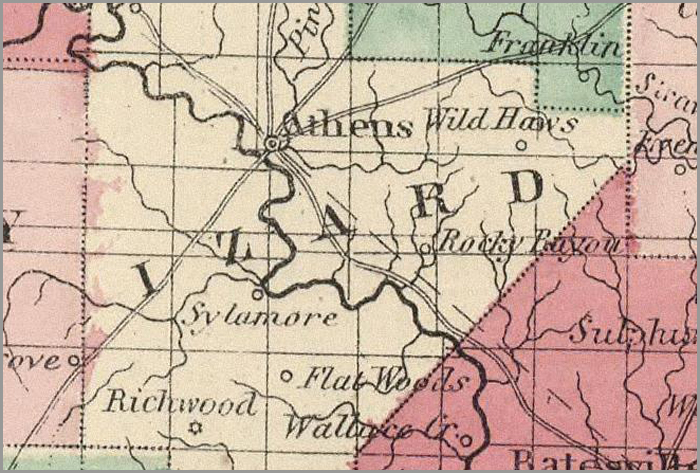Izard County, Arkansas

- Formed: October 17, 1827
- County Population 1860: 6,783
- Slave Population 1860: 453
- Civil War Engagements
-Skirmish at Calico Rock Landing, May 26, 1862
Image courtesy of David Rumsey Historical Map Collection
Izard County, Arkansas is located in the White River, Strawberry River, and Mill Creek. It contains abundant wild game, fish, and timber resources. The soil is conducive to growing wheat, sorghum, various vegetables, and tobacco. There is also sufficient grazing land to raise livestock. The area was originally the territory of the Osage and Shawnee. White settlement began early when John Lafferty, an Ireland Native, moved to the area from North Carolina in 1810. The area he settled became known was Lafferty Creek. The first slave owner, Jehoiada Jeffrey, moved to the county in 1819. Most early settlers came from Tennessee, Kentucky, North Carolina, or South Carolina. The slave population rose to 453 individuals by 1860.
Izard County was officially established on October 17, 1827 from part of Independence County. It was named after George Izard, a governor of the Arkansas territory. Izard’s first county seat was Liberty, which was later renamed Norfork. The population grew steadily leading up to the Civil War, helped in part through the business boom resulting from the huge influx of military and government personnel who passed through the area in 1838, escorting the Cherokee along the Trail of Tears to their reservation in Indian Territory (modern day Oklahoma). In 1830, the population was 1,266 people, 2,240 people in 1840, 3,213 people in 1850, and 7, 215 people in 1860.
When the Civil War began in 1861, most residents empathized with the Confederacy, through many protested Arkansas’ secession from the Union. In May 1861, several residents who opposed all involvement on either side of the war formed the Mill Creek Peace Organization Society. Most members were eventually arrested, shot, or sent to prison under Arkansas Governor Henry Massie Rector’s orders. Izard County men fought in several military regiments, including 7th and 14th Arkansas Infantries. There were no major battles within the County boundaries, but there were several skirmishes in 1862 and 1863. Early skirmishes between Rebel and Union troops occurred at Calico Rock Landing on May 26, 1862, Sylamore three days later, and Mt. Olive on June 17, 1862. Confederate Colonel Thomas R. Freeman? led his bushwhackers against Union troops in skirmishes north of Oxford (December 10, 1863) and at Lunenburg (January 20, 1864). In January 1864, Union troops under the command of Lieutenant Colonel William Baumer were ordered to hunt down Freeman. The troops attacked Mt. Olive and Sylamore, burning both towns.
After the war, recovery was extremely slow. Due to adverse weather conditions, crops failed for two years after the war was over, leaving many residents starving, many were forced to leave the county and go elsewhere. However, a few years later, residents began growing cotton, corn, and wheat and raising pigs and cattle for profit. The abundant pine forests in the area where also used for profit. The population suffered greatly from the war, with 6,806 people in 1870, down almost 500 people from 1860. Though reconstruction was gradual, residents did eventually recover from the devastating affects of the war.
 Browse all collections in Izard County
Browse all collections in Izard County
- Consulted:
- http://www.encyclopediaofarkansas.net/encyclopedia/entry-detail.aspx?search=1&entryID=777.
- Izard County, AK, 1860 U.S. Federal Census – Slave Schedules [database on-line]. Provo, UT, USA: Ancestry.com Operations Inc, 2004. Original data: United States of America, Bureau of the Census. Eighth Census of the United States, 1860. Washington, D.C.: National Archives and Records Administration, 1860. M653, 1,438 rolls.












